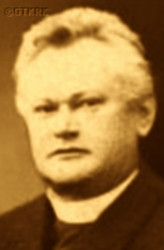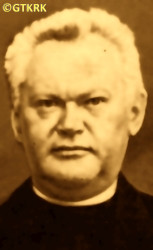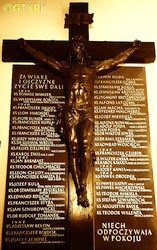Roman Catholic
St Sigismund parish
05-507 Słomczyn
85 Wiślana Str.
Konstancin deanery
Warsaw archdiocese, Poland
full list:
displayClick to display full list

searchClick to search full list by categories
wyświetlKliknij by wyświetlić pełną listę po polsku

szukajKliknij by przeszukać listę wg kategorii po polsku

Martyrology of the clergy — Poland
XX century (1914 – 1989)
personal data
surname
GĄSKA
surname
versions/aliases
GONSKA
forename(s)
Rudolph Augustus Walter (pl. Rudolf August Walter)
function
diocesan priest
creed
Latin (Roman Catholic) Church RCmore on
en.wikipedia.org
[access: 2014.09.21]
diocese / province
Katowice diocesemore on
en.wikipedia.org
[access: 2013.05.19]
Apostolic Administration of Upper Silesiamore on
www.catholic-hierarchy.org
[access: 2021.12.19]
Wrocław diocesemore on
en.wikipedia.org
[access: 2013.05.19]
date and place
of death
02.12.1943

Wrocławtoday: Wrocław city pov., Lower Silesia voiv., Poland
more on
en.wikipedia.org
[access: 2021.04.02]
details of death
During theological studies in Wrocław, despite the generally negative opinion of Jerzy Cardinal Kopp, Archbishop of Wrocław, a member of the „Polish Circle” operating in the archiepiscopal boarding house from 10.11.1895, the aim of which was to increase the level of knowledge of the Polish language among alumni preparing for the sacrament of priesthood.
During the preparations for the plebiscite ordered by the provisions of the Treaty of Versailles of 28.06.1919, ending the World War I, which was to decide on 20.03.1921 the national affiliation of Upper Silesia and the Opole region, attacked by German thugs and badly beaten.
Arrested by the Germans and held in Racibórz jail. Released after 7 months.
Left Zabełków parish that, after a plebiscite, by the decision of the Council of the League of Nations of 10.1921, approved by the Council of Ambassadors, i.e. the international executive body of the Versailles Conference, was awarded to Germany, and moved to Koszęcin awarded to Poland, though most of the votes there in plebiscite (68%) where casted for Germany — only 32% for Poland.
Became an active member of Polish Western Borderlands Defence Union.
After German and Russian invasion of Poland in 09.1939 and start of the World War II, after start of German occupation, left his Koszęcin parish.
Went into hiding in Chorzów, Tarnowskie Góry and finally in Wrocław, at St Joseph Institute in Janowice run by Marian nuns SMI.
There arrested by the Germans on 22.02.1943 — including 3 nuns and a local priest.
Accused of treason and involvement in a plot to remove Hitler from power.
There are indication he might have been involved — under nom‐de‐guerre „Meyer” — in founding a clandestine organization consisting of Czechs, Poles and French seeking opportunities to help prisoners of war and foreigners, and in a wider context, participating in preparation of an attempt at Hitler's life in 04.1944.
During interrogations took all the blame on himself.
The first trial by German Germ. Sondergericht (Eng. special court) took place in 10.1943.
The second started on 18.11.1943 and he had to be carried into the court.
Prob. poisoned — before the sentence was passed — in Wrocław prison and perished.
cause of death
murder
perpetrators
Germans
sites and events
Ribbentrop‐MolotovClick to display the description, Pius XI's encyclicalsClick to display the description, Silesian UprisingsClick to display the description
date and place
of birth
04.04.1875Birth certification on:
photos.szukajwarchiwach.gov.pl
[access: 2025.08.19]

Huta Lauratoday: part of Centrum district in Siemianowice Śląskie, Siemianowice Śląskie city pov., Silesia voiv., Poland
more on
en.wikipedia.org
[access: 2021.12.18]
parents
GĄSKA Augustus
🞲 ?, ? — 🕆 ?, ?

MUTKE Mary
🞲 ?, ? — 🕆 ?, ?
presbyter (holy orders)
ordination
22.06.1901

Wrocławtoday: Wrocław city pov., Lower Silesia voiv., Poland
more on
en.wikipedia.org
[access: 2021.04.02]
positions held
1922 – 1939
parish priest — Koszęcintoday: Koszęcin gm., Lubliniec pov., Silesia voiv., Poland
more on
en.wikipedia.org
[access: 2022.05.23] ⋄ Sacred Heart of Jesus RC parish ⋄ Lubliniectoday: Lubliniec urban gm., Lubliniec pov., Silesia voiv., Poland
more on
en.wikipedia.org
[access: 2021.04.02] RC deanery
24.04.1913 – 1922
parish priest — Zabełkówtoday: Krzyżanowice gm., Racibórz pov., Silesia voiv., Poland
more on
en.wikipedia.org
[access: 2022.01.28] ⋄ St Hedwig of Silesia RC parish ⋄ Tworkówtoday: Krzyżanowice gm., Racibórz pov., Silesia voiv., Poland
more on
en.wikipedia.org
[access: 2021.04.02] RC deanery
c. 1913
vicar — Sudółtoday: district of Racibórz, Racibórz urban gm., Racibórz pov., Silesia voiv., Poland
more on
en.wikipedia.org
[access: 2021.04.02] ⋄ Our Lady of the Rosary RC parish ⋄ Tworkówtoday: Krzyżanowice gm., Racibórz pov., Silesia voiv., Poland
more on
en.wikipedia.org
[access: 2021.04.02] RC deanery
c. 1912
vicar — Góra Świętej Annytoday: Leśnica gm., Strzelce Opolskie pov., Opole voiv., Poland
more on
en.wikipedia.org
[access: 2021.04.02] ⋄ Exaltation of the Holy Cross RC church ⋄ Leśnicatoday: Leśnica gm., Strzelce Opolskie pov., Opole voiv., Poland
more on
en.wikipedia.org
[access: 2021.08.12], Holy Trinity RC parish ⋄ Ujazdtoday: Ujazd gm., Strzelce Opolskie pov., Opole voiv., Poland
more on
en.wikipedia.org
[access: 2021.04.02] RC deanery
19.09.1901 – c. 1912
vicar — Świętochłowicetoday: Świętochłowice city pov., Silesia voiv., Poland
more on
en.wikipedia.org
[access: 2021.04.02] ⋄ St Peter and St Paul the Apostles RC parish ⋄ Mysłowicetoday: Mysłowice city pov., Silesia voiv., Poland
more on
en.wikipedia.org
[access: 2021.04.02] RC deanery
till 1901
student — Wrocławtoday: Wrocław city pov., Lower Silesia voiv., Poland
more on
en.wikipedia.org
[access: 2021.04.02] ⋄ philosophy and theology, Department of Catholic Theology, University of Wrocław [i.e. University of Wrocław (since 1945) / Frederic Wilhelm University of Silesia (1911‐1945) / Royal University i.e. Breslau Academy (1816‐1911)]
activist — Polish Association for the Defense of the Western Borderlands
sites and events
descriptions
Ribbentrop‐Molotov: Genocidal Russian‐German alliance pact between Russian leader Joseph Stalin and German leader Adolf Hitler signed on 23.08.1939 in Moscow by respective foreign ministers, Mr. Vyacheslav Molotov for Russia and Joachim von Ribbentrop for Germany. The pact sanctioned and was the direct cause of joint Russian and German invasion of Poland and the outbreak of the World War II in 09.1939. In a political sense, the pact was an attempt to restore the status quo ante before 1914, with one exception, namely the „commercial” exchange of the so‐called „Kingdom of Poland”, which in 1914 was part of the Russian Empire, fore Eastern Galicia (today's western Ukraine), in 1914 belonging to the Austro‐Hungarian Empire. Galicia, including Lviv, was to be taken over by the Russians, the „Kingdom of Poland” — under the name of the General Governorate — Germany. The resultant „war was one of the greatest calamities and dramas of humanity in history, for two atheistic and anti‐Christian ideologies — national and international socialism — rejected God and His fifth Decalogue commandment: Thou shall not kill!” (Abp Stanislav Gądecki, 01.09.2019). The decisions taken — backed up by the betrayal of the formal allies of Poland, France and Germany, which on 12.09.1939, at a joint conference in Abbeville, decided not to provide aid to attacked Poland and not to take military action against Germany (a clear breach of treaty obligations with Poland) — were on 28.09.1939 slightly altered and made more precise when a treaty on „German‐Russian boundaries and friendship” was agreed by the same murderous signatories. One of its findings was establishment of spheres of influence in Central and Eastern Europe and in consequence IV partition of Poland. In one of its secret annexes agreed, that: „the Signatories will not tolerate on its respective territories any Polish propaganda that affects the territory of the other Side. On their respective territories they will suppress all such propaganda and inform each other of the measures taken to accomplish it”. The agreements resulted in a series of meeting between two genocidal organization representing both sides — German Gestapo and Russian NKVD when coordination of efforts to exterminate Polish intelligentsia and Polish leading classes (in Germany called «Intelligenzaktion», in Russia took the form of Katyń massacres) where discussed. Resulted in deaths of hundreds of thousands of Polish intelligentsia, including thousands of priests presented here, and tens of millions of ordinary people,. The results of this Russian‐German pact lasted till 1989 and are still in evidence even today. (more on: en.wikipedia.orgClick to attempt to display webpage
[access: 2015.09.30])
Pius XI's encyclicals: Facing the creation of two totalitarian systems in Europe, which seemed to compete with each other, though there were more similarities than contradictions between them, Pope Pius XI issued in 03.1937 (within 5 days) two encyclicals. In the „Mit brennender Sorge” (Eng. „With Burning Concern”) published on 14.03.1938, condemned the national socialism prevailing in Germany. The Pope wrote: „Whoever, following the old Germanic‐pre‐Christian beliefs, puts various impersonal fate in the place of a personal God, denies the wisdom of God and Providence […], whoever exalts earthly values: race or nation, or state, or state system, representatives of state power or other fundamental values of human society, […] and makes them the highest standard of all values, including religious ones, and idolizes them, this one […] is far from true faith in God and from a worldview corresponding to such faith”. On 19.03.1937, published „Divini Redemptoris” (Eng. „Divine Redeemer”), in which criticized Russian communism, dialectical materialism and the class struggle theory. The Pope wrote: „Communism deprives man of freedom, and therefore the spiritual basis of all life norms. It deprives the human person of all his dignity and any moral support with which he could resist the onslaught of blind passions […] This is the new gospel that Bolshevik and godless communism preaches as a message of salvation and redemption of humanity”… Pius XI demanded that the established human law be subjected to the natural law of God , recommended the implementation of the ideal of a Christian state and society, and called on Catholics to resist. Two years later, National Socialist Germany and Communist Russia came together and started World War II. (more on: www.vatican.vaClick to attempt to display webpage
[access: 2023.05.28], www.vatican.vaClick to attempt to display webpage
[access: 2023.05.28])
Silesian Uprisings: Three armed interventions of the Polish population against Germany in 1919‐1921 aiming at incorporation of Upper Silesia and Opole region into Poland, after the revival of the Polish state in 1918. Took place in the context of a plebiscite ordered on the basis of the international treaty of Versailles of 28.06.1919, ending the First World War, that was to decide national fate of the disputed lands. The 1st Uprising took place on 16‐24.08.1919 and broke out spontaneously in response to German terror and repression against the Polish population. Covered mainly Pszczyna and Rybnik counties and part of the main Upper Silesia industrial district. Suppressed by the Germans. 2nd Uprising took place on 19‐25.08.1920 in response to numerous acts of terror of the German side. Covered the entire area of the Upper Silesia industrial district and part of the Rybnik county. As a result Poles obtained better conditions for the campaign prior the plebiscite. The poll was conducted on 20.03.1921. The majority of the population — 59.6% — were in favor of Germany, but the results were influenced by the admission of voting from former inhabitants of Upper Silesia living outside Silesia. As a result the 3rd Uprising broke out, the largest such uprising of the Silesian in the 20th century. It lasted from 02.05.1921 to 05.07.1921. Spread over almost the entire area of Upper Silesia. Two large battles took place in the area of St. Anna Mountain and near Olza. As a result on 12.10.1921 the international plebiscite commission decided on a more favorable for Poland division of Upper Silesia. The territory granted to Poland was enlarged to about ⅓ of the disputed territory. Poland accounted for 50% of metallurgy and 76% of coal mines. (more on: en.wikipedia.orgClick to attempt to display webpage
[access: 2020.05.25])
sources
personal:
encyklo.plClick to attempt to display webpage
[access: 2021.12.19], bsip.miastorybnik.plClick to attempt to display webpage
[access: 2020.05.25], photos.szukajwarchiwach.gov.plClick to attempt to display webpage
[access: 2025.08.19]
original images:
www.koszecin-nspj.plClick to attempt to display webpage
[access: 2013.08.10], www.alamy.comClick to attempt to display webpage
[access: 2023.08.22]
LETTER to CUSTODIAN/ADMINISTRATOR
If you have an Email client on your communicator/computer — such as Mozilla Thunderbird, Windows Mail or Microsoft Outlook, described at WikipediaPatrz:
en.wikipedia.org, among others — try the link below, please:
LETTER to CUSTODIAN/ADMINISTRATORClick and try to call your own Email client
If however you do not run such a client or the above link is not active please send an email to the Custodian/Administrator using your account — in your customary email/correspondence engine — at the following address:

giving the following as the subject:
MARTYROLOGY: GĄSKA Rudolph Augustus Walter
To return to the biography press below:
 Click to return to biography
Click to return to biography










